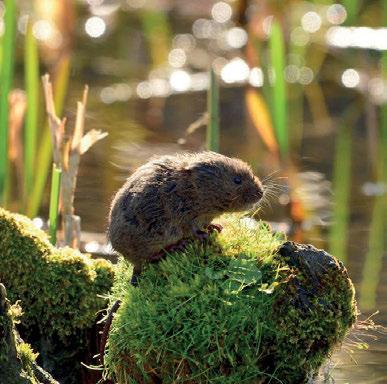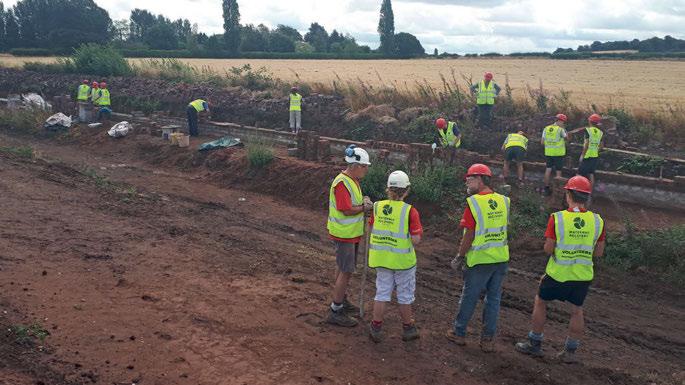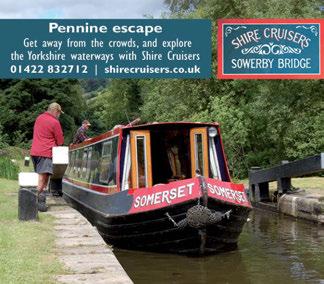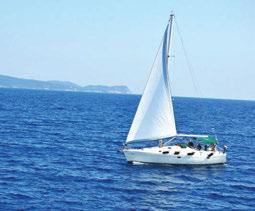
8 minute read
Restoration Hub
What biodiversity means for the waterways
Canals connect many habitats that need to be considered when restoration works are being planned.
Managing impacts on biodiversity has long been part of infrastructure development. However, with the huge amounts of money promised by Government over the coming years for such Protecting wildlife habitats areas as road and rail transport, is a key part of development. housing, energy, flood defence and communications, the potential for devastating consequences for the environment has become very real. Declarations on the joint climate and biodiversity crisis by private and public sector organisations escalated during 2019, placing biodiversity loss, and the need to address it, at the centre of political and public discussions.
The question now being asked is: how do we improve infrastructure while protecting, and ideally enhancing, biodiversity? A new approach called Biodiversity Net Gain looks to be the answer.

What is BNG?
The concept of BNG is simple: it is development that leaves biodiversity in a measurably better state than before. It requires a shift from an ‘infrastructure versus nature’ approach, to one where infrastructure is designed, built and maintained in ways that benefit our environment.
Some major industry players have made voluntary commitments to BNG, including Highways England, housing developers such as Berkeley Homes and Barratt Homes, and water companies like South West Water. There are also local planning authorities stipulating BNG, including Warwickshire and Lichfield. Government is now catching up and last year published the Environment Bill’s policy statement setting out a mandatory approach to BNG for development in England. Also, Natural England issued the Biodiversity Metric 2.0 for measuring losses and gains in biodiversity from development.

Good practice
To help address the challenge of how to adopt a combined ‘infrastructure and nature’ approach, leading environmental institutes, including the Chartered Institute of Ecology & Environmental Management, Construction Industry Research & Information Association, and Institute of Environmental Management & Assessment, have published Biodiversity Net Gain: Good Practice Principles for Development. These principles provide a framework for achieving BNG and are relevant to the construction industry, local authorities, NGOs, landowners and land managers. They have been widely cited as a benchmark for good practice, and

Inclusion of Biodiversity Net Gain can be expected within all aspects of waterways restoration.

guidance to support their implementation has also been published.
The only issue is that these principles are very hard to apply to waterways restoration. A canal or river project is long, thin and not confined to one distinct area, as most construction projects are. Waterways can extend through many different environments and the calculation for measuring losses and gains becomes much more complex.
IWA has issued separate guidance for use by restoration societies and trusts to explain the details of BNG. However, it is only as BNG becomes embedded in the planning system that we will really understand how to apply it to restoration.
How does BNG affect waterways restoration?
Biodiversity Net Gain will fundamentally change the way we approach waterway restoration in the future. Where previously biodiversity and the environment would have been an afterthought or a nice ‘added extra’, BNG will require developers and construction organisations to put them at the heart of all activities from project inception to ongoing aftercare.
This means restoration groups will need to reassess current activities and strategies to cater for the eventual inclusion of BNG within the planning framework. Traditionally, developers might have sought to mitigate the loss of habitat caused by their project by creating/adding/offsetting other habitats, often in localities away from the ecological footprint of their project; BNG will require them to ensure habitats are replaced on a like-for-like basis. For example, replacing a river with a woodland just won’t do anymore. Woodland should be replaced by woodland and, where possible, enhancement measures added. Sometimes a like-for-like approach is not always possible and in these cases, the project should look at ‘trading up’, which means taking a low priority habitat, like amenity grassland, and converting it into a priority habitat, like a reed bed.
Restorations will need to consider some key points when habitat trading to: ■ Avoid losing biodiversity that cannot be offset ■ Ensure the gains exceed the area lost ■ Deliver a project that goes beyond current obligations ■ Ensure the trade makes sense and achieve the best possible outcomes for biodiversity ■ Think carefully about the role that the existing habitat plays and that the habitat trade delivers the same needs for species present ■ Make sure the trade is possible and can be achieved.
Not all habitats are created equal
Size, designation, connectivity and protected and invasive species all play a part in the calculations for new habitats. Of these, connectivity is of particular interest to waterways restorations due to their linear nature. They have the potential to link habitats that were not previously connected, and the effects of this will need to be taken into account.
Where possible, compensation measures should be applied on site or as close as possible to the location of the development works. Net gain should contribute towards priorities set out in local authority plans and other governing documents, with an emphasis on the features affected by the development.
The sorts of features that restorations will need to consider when thinking about the location for mitigating projects include: ■ Soil characteristics ■ National/local populations ■ Connectivity ■ Foraging opportunities ■ Refuge ■ Barriers ■ Proximity to urban areas ■ Strategic location
For a restoration that is 25 miles long, these sorts of calculations could become immensely complex.
Habitats affected by development should be replaced on a likefor-like basis.
The cost to restoration
Responsibility to meet BNG falls under a number of key roles during the project lifecycle, and there needs to be ongoing management within the habitat for up to 30 years after the works have been completed. Restorations will have to measure, record and report if each habitat is meeting the net gain outcomes set out in the project plans. Future management can be passed onto a third party, such as a statutory nature conservation organisation, local authority or charity group, but budgets and support must be taken into consideration to allow this to happen.
Restorations will be able to put BNG costs into funding bids, as grant-giving organisations are now looking at ensuring the environment is fully accounted for within their funded projects. The cost implications for restorations, however, may be considerable.
Thankfully, restoration groups would not be expected to independently review the biodiversity value of the canal route. This would most likely be left to a qualified ecologist to ascertain the pre- and postconstruction biodiversity levels, involving a further cost to the restoration.
Opportunities
Despite the potential costs to restoration groups, there are opportunities for waterways projects to present themselves as the net gain benefit for other infrastructure developments. Very often, canal restoration trusts and societies own or manage the land through which their restorations run, and developers working within these areas may be looking for sites and projects that could support their own BNG projects.
As BNG becomes mandatory, restoration groups could find themselves in the happy situation of being asked to support developers in the provision of mitigation measures. In providing such measures, the waterways organisations may ask the developer for some support in exchange, and this could in turn benefit the progress of the restoration. A win for the environment and for restoration!
For a copy of IWA’s Biodiversity Net Gain guidance note, visit waterways.org.uk/biodiversity.
BOATS FOR hirE
FOR THE WIDEST CHOICE of canal holidays visit www.abcboathire.com. You can choose from 14 different start locations and more than 200 boats. We operate Viking Afloat, Alvechurch Waterways Holidays, Red Line Boats and Wessex Narrowboats. So go online today or call 0330 3330590 (local rate) for a brochure.


BOAT PAINTING
BOAT PAINTING SPECIALISTS GRITBLASTING OPTIONS AVAILABLE
Est 1964 07866 022686
info@canaltransportservices.co.uk www.canaltransportservices.co.uk
Visit the Inland Waterways Association Bookshop for some great gift ideas including canal guides and practical books. Call 01494 783453 or visit www.iwashop.com
iwa classified advertising
Lineage adverts cost £1.38 per word (inc. VAT), minimum 12 words. Box adverts start from as little as £33 per issue (plus VAT)*. A copy of our terms and conditions is available on request. (*4 series booking)
INSURANCE

BASIC BOAT
LIABILITY COMPANY
UK’S NUMBER 1 MARKET LEADER IN BOAT LIABILITY INSURANCE
Third Party Liability No Excess £5M Level of Indemnity Upto £50k for Wreck Removal
03333 219 430
www.basic-boat.com
PA727BB01
THIS COMPANY IS PART OF HOWE MAXTED GROUP WHO ARE AUTHORISED AND REGULATED BY THE FINANCIAL CONDUCT AUTHORITY
mail forwarding boatmail.co.uk
The boaters mail forwarding company. Unique ‘Pay as you Go’ service.
07984 215873 • info@boatmail.co.uk
LEGAL
WILLS, LASTING POWERS OF ATTORNEY, PROBATE ADVICE AND ESTATE ADMINISTRATION LIMITED VERY SPECIAL PRICES FOR SIMPLE NON CONTACT DOCUMENTS
Single Wills from £85. Mirror Wills from £165. Lasting Powers of Attorney £595 inclusive of registration. We can arrange to telephone or email instructions. Also available personal consultation and attended attestation. DIGITAL AND TRADITIONAL DOCUMENT STORAGE,
PROTECTIVE TRUSTS, PREPAID FUNERAL PLANS T: 01283 320992 E: wills@allwillsandtrusts.co.uk
RUN BY BOATERS FOR BOATERS
PAINT
SERVICES TRAVEL SAT

For all your satellite and television requirements NATIONWIDE FITTING SERVICE 07914 401036 • travelsat.me.uk
REACH THE IWA'S MEMBERSHIP
Effective, affordable advertising. To advertise in this section call Jake Tyers on 01283 742977 or email: j.tyers@wwonline.co.uk










